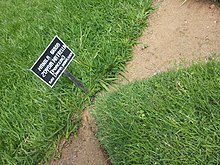Zoysia matrella
| Zoysia matrella | |
|---|---|
 |
|
| at Peradeniya Botanical Garden | |
| Scientific classification | |
| Kingdom: | Plantae |
| (unranked): | Angiosperms |
| (unranked): | Monocots |
| (unranked): | Commelinids |
| Order: | Poales |
| Family: | Poaceae |
| Subfamily: | Chloridoideae |
| Tribe: | Cynodonteae |
| Genus: | Zoysia |
| Species: | Z. matrella |
| Binomial name | |
|
Zoysia matrella (L.) Merr. |
|
| Synonyms | |
|
|
Zoysia matrella (L.) Merr., commonly known as Manila grass, is a species of mat-forming, perennial grass native to temperate coastal southeastern Asia and northern Australasia, from southern Japan (Ryukyu Islands), Taiwan, and southern China (Guangdong, Hainan) south through Thailand, Indonesia, Malaysia and the Philippines to northern Australia (northeast Queensland), and west to the Cocos Islands in the eastern Indian Ocean.
Other common names include Korean grass, Manila templegrass, siglap grass (after an area in Singapore), temple grass, Mascarene grass, harishiba, hierba Manila (Spanish), Japanese carpet, jukut kakawatan hijau (Sundanese), rebha sekem-sekeman (Madurese), burikit (on Seram), rumput siglap (Malay), damong-alat, barit-baritan (Tagalog), malakuwerdas (Pangasinan), ya-nuannoi (Thai).
It forms extensive, velvety, green mats, spreading vigorously by stolons, or occasionally by rhizomes, once established. Z. matrella grows in low elevation preferring sandy soils where other grasses establish poorly. The stems are slender and prostrate, ranging from 5–25 cm in length. The leaves are alternate, produced at 1.5–3 cm intervals along the stem; they are slender, 2–10 cm long and 1–3 mm broad. The flowers are greenish, produced on erect racemes 6–35 mm long with a single 2-3.5 mm flower in each spikelet.
...
Wikipedia
